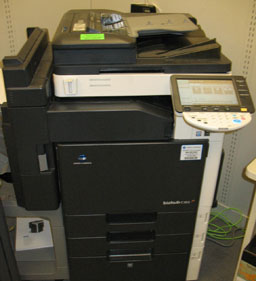In accordance with Department of Energy SSPP and best practices, Sandia is committed to electronics stewardship – purchasing computer systems designed with the environment in mind. “Green” electronics are defined as equipment whose manufacture, operation, and end of life have reduced environmental impact.
Electronics stewardship is divided into three phases of product lifecycle. Outlined below are Sandia initiatives to address these phases:
Acquisition
The federal government has identified the Electronic Product Environmental Assessment Tool (EPEAT) as a comprehensive means to evaluate many factors that affect the environmental impacts of electronic equipment. A few components of the 51 criteria EPEAT examines include:
- reduction/elimination of environmentally sensitive materials
- material selection
- design for end of life
- product longevity/life-cycle extension
- energy conservation (minimum requirement is Energy Star)
- manufacturer end-of-life management
- manufacturer corporate performance
- packaging
Since 2018, Sandia has won an EPEAT award from the Green Electronics Council for the procurement of EPEAT registered office electronics. Sandia has incorporated EPEAT registration into its IT purchasing contracts, bid language, and an internal order web page where users can see EPEAT ratings on all computing equipment to be purchased.
Operations
Sandia is working to reduce the impacts of computing equipment during daily operation. This includes institutionalizing duplex printing, reducing printers on site, increasing the use of multi-function imaging equipment, and ensuring power management on computers. Power used by desktop computers is the largest impact of this phase. In 2010, Sandia began implementing power management software that allows precision control of power management features on all networked computers. Sandia’s computer services group tracks power usage Labs-wide, set power-limiting features in all devices that are not required to run constantly, and watch the savings in power, dollars, and carbon emissions add up.

End of Life
When electronics are no longer compatible with Sandia’s operating environment, or replacement equipment is purchased, excess items are returned to Logistics and made available to other departments at Sandia and to the federal community. If not selected for reuse computers (e.g., towers, laptops, monitors) meeting certain performance criteria can be donated to local schools. All remaining equipment not reused or donated, including servers, mobile devices, imaging equipment, and non-functional electronics, are sent to an e-Stewards certified recycling facility where they are safely and compliantly de-manufactured and segregated for reuse of their constituent components and materials.
Energy Star
 Energy Star is a prerequisite of the Electronic Product Environmental Assessment Tool (EPEAT) designation. If an office computing product needed is not on the EPEAT registry, then Energy Star certification becomes the minimum requirement for purchases of energy-using equipment at Sandia.
Energy Star is a prerequisite of the Electronic Product Environmental Assessment Tool (EPEAT) designation. If an office computing product needed is not on the EPEAT registry, then Energy Star certification becomes the minimum requirement for purchases of energy-using equipment at Sandia.